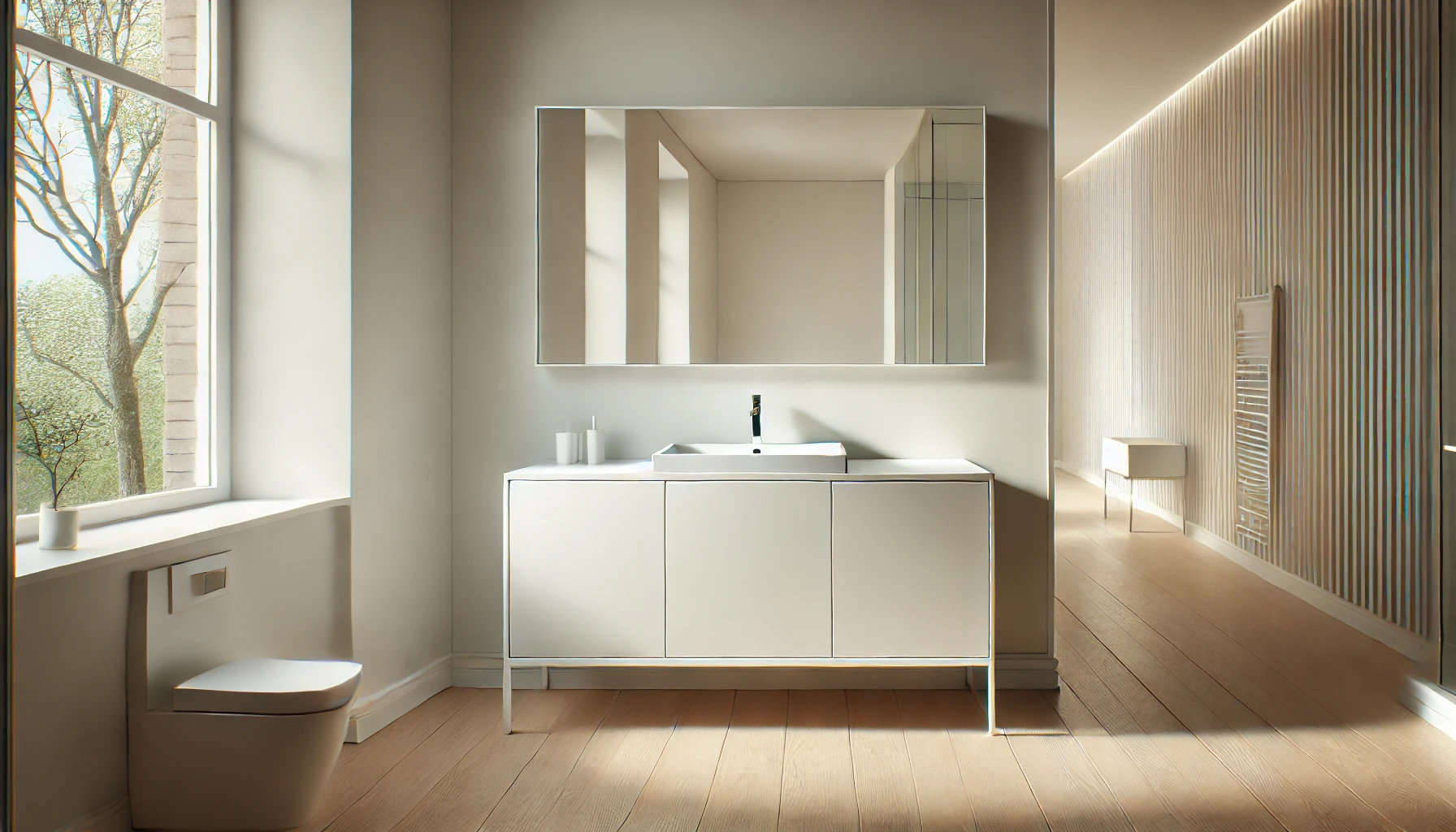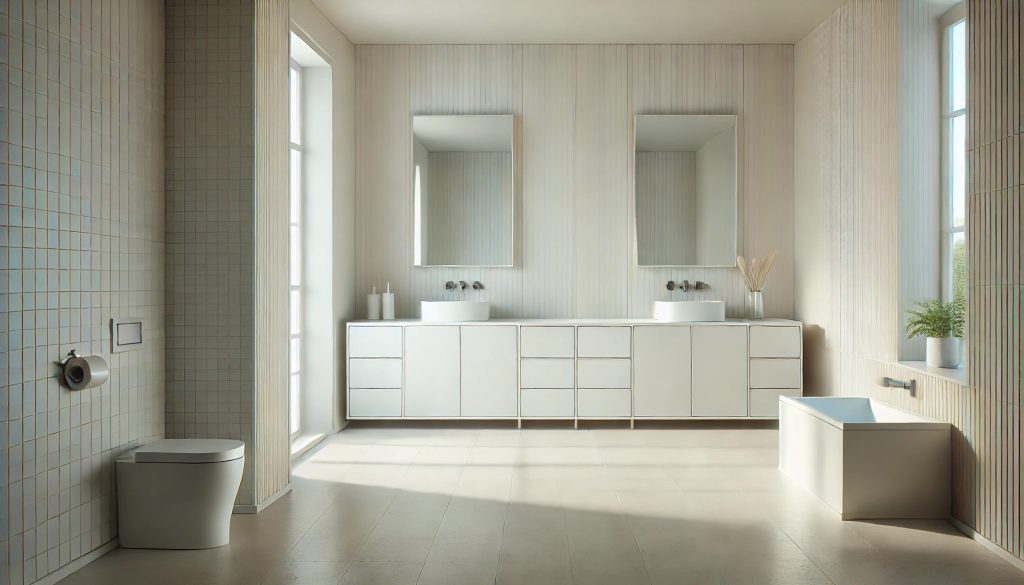1. Choosing the Right Bathroom Vanity for Your Space
You don’t realize how much of your daily routine revolves around your bathroom until you’ve lived with a poorly designed vanity unit. I learned this the hard way when I first moved into an older house. The bathroom vanity unit was tiny, outdated, and—worst of all—completely impractical. There was barely enough countertop space for a toothbrush holder, much less my skincare lineup. That’s when I realized the importance of picking out the right bathroom vanity for your space, and let me tell you, it’s not as simple as walking into a store and pointing to the prettiest option.
Size
Trust me, measuring isn’t one of those tasks you can skip or “eyeball.” Many people, myself included during my earlier renovation attempts, forget to account for clearance space. While you might fall in love with one of those giant bathroom vanities that make a statement, it could end up taking over your bathroom and making movement awkward. Pro tip: you’ll want to leave at least 21 inches of floor space in front of the vanity unit with basin—and even more for drawers and doors to open fully.
Storage
A good sink and vanity unit combo can make a world of difference in organisation. If you’re like me and find yourself buried in random toiletries, a vanity unit with proper drawers is a game changer. When you’re shopping for bathroom vanity units, look underneath—don’t just focus on the top! Those open shelving vanities might be trendy, but if you’re not someone who keeps everything neat and tidy, closed storage will keep things looking clean and serene. It’s like having a little secret: all the chaos is behind those cabinet doors while the outside still looks Instagram-ready.
Material
Bathrooms are damp environments, so you’re going to need a sturdy bathroom vanity unit made from water-resistant materials. MDF or solid wood with protective coatings is a popular choice. I bought my first vanity unit without thinking about this and within a year, I noticed swelling around the edges. Now, I’m always double-checking for materials designed specifically for bathroom environments.
Style
Style counts! You want your vanity unit to complement the overall aesthetic of your bathroom. Whether you’re going for a modern vibe with a sleek white bathroom vanity unit, or something more traditional with wood finishes, it should feel cohesive. When I upgraded to a floating sink and vanity unit, it instantly made my small bathroom feel more spacious and elegant. Bonus: it was so much easier to clean underneath!
So, before you pick out your bathroom vanity unit, think about size, storage, material, and style. Make sure it’s not just a pretty face—because a functional vanity will save you so many headaches in the long run.
How to Choose the Perfect Bathroom Vanity Unit for Your Space
Alright, I’ll admit it – choosing a bathroom vanity unit can feel a bit like falling down a rabbit hole. There are just so many options: different styles, sizes, colors, and configurations that could completely change the vibe of your bathroom. But after remodelling my bathroom last year, I’ve learned a thing or two about picking the right bathroom vanity unit – and let me tell you, it’s a lot more than just picking something that looks pretty. You need to think about functionality, style, and how it fits with the rest of your space. So let’s break it down.
Size Matters
And honestly, I cannot stress this enough. Measure your bathroom space meticulously before even looking at your options. My first attempt at buying a bathroom vanity unit was an epic fail. I bought this stunning vanity unit with basin, that didn’t even fit through the bathroom door, let alone leave enough space to move around once installed. Pro tip: Always measure not just the available floor space but also consider how the vanity will work with the surrounding area. Will the cabinet doors swing open easily? Is there enough clearance between the vanity and the toilet? Thinking about these small but important details will save you from a ton of regret later.
Storage is Key
Let’s be honest—clutter piles up fast in a bathroom. Toothpaste tubes, hairdryers, makeup brushes, cleaning supplies… you get the idea. A bathroom vanity unit with multiple storage compartments can be your best friend, especially if you’re like me and can’t stand the sight of countertop mess. Opt for a vanity unit with deep drawers or shelves where you can neatly organize all your bathroom essentials. Some vanity units even come with built-in organizers, which feels like a total game-changer.
Don’t Ignore Materials and Durability
Bathrooms are high-moisture areas, so materials like solid wood or water-resistant MDF are much better choices than particle board, which tends to swell and warp over time. When I swapped out my old sink and vanity unit for a newer model made with high-quality MDF and a water-resistant laminate finish, it was a world of difference. Not only did it last longer, but it also looked brand new for years.
Prioritize Style and Aesthetics
Your bathroom vanity unit should seamlessly blend with the overall theme of your bathroom. Whether you’re going for sleek and modern or timeless and traditional, there’s a vanity unit to match. For example, a vanity unit with basin and chrome fixtures can give a minimalist bathroom that spa-like aesthetic, while a rustic wood finish might bring some cozy, farmhouse vibes. Obviously, choose something you love, but make sure it complements your space.
Functionality and Daily Use
When choosing a vanity unit, think about how easy it will be to maintain and use daily. Does the sink’s height feel comfortable? Is there enough surface area for your toiletries? Are the basins easy to clean? I made the mistake of choosing a vanity unit with a beautiful vessel sink mounted on top. It looked fantastic, but every time I washed my hands, water splashed everywhere. Lesson learned—don’t sacrifice practicality for aesthetics.
Don’t Overlook Hardware
The knobs, handles, and hinges on bathroom vanity units often get overlooked, but they can either elevate or cheapen the entire look of your bathroom. Plus, poorly made hardware can wear out quickly, which is not something you want to deal with a few months after installation. Choose something stylish yet sturdy.
Conclusion: Bringing It All Together
When it comes to upgrading your space, bathroom vanities often play a more critical role than people realize. Your vanity unit should be practical but also align with your personal style. For example, if you have a modern, minimalist bathroom, a floating vanity unit with a basin can work wonders. On the other hand, if you’re aiming for something timeless and elegant, classic wooden bathroom vanity units with clean lines will never steer you wrong.
Another thing to prioritize is storage. A sink and vanity unit combination with plenty of drawers or cabinets will save you the headache of hunting for your toothbrush or makeup in the morning rush. Even in smaller bathrooms, compact bathroom vanity units can keep your space organized while still looking chic.
In the end, choosing the perfect bathroom vanity unit isn’t rocket science, but it does take a little thought. Keep in mind the size of your space, your storage needs, and your style preferences, and you’ll nail it. It’s a simple update that can make a massive impact on your daily routine. And hey, if you’re still not sure, just start small. Sometimes all it takes is swapping out an outdated piece for a fresh sink and vanity unit to completely revitalize your bathroom. Trust me—once you get it right, you’ll wonder why you didn’t do it sooner!
FAQs
1. What is the best material for bathroom vanities?
The best material depends on your bathroom’s style and moisture levels. Solid wood is durable and timeless, while MDF or plywood-based vanities are more budget-friendly. Look for water-resistant finishes to keep your bathroom vanity unit in tip-top shape.
2. How do I choose the right size bathroom vanity unit?
Start by measuring the available space, including width, depth, and height. You’ll also want to ensure there’s enough clearance for doors or drawers to open. For compact spaces, go for smaller vanity units or a floating vanity that creates the illusion of a bigger room.
3. Are double sink and vanity units worth it?
Double sink and vanity units are great for shared bathrooms, providing personal space for two people. They’re especially valuable in master bathrooms and can add a touch of luxury. However, they may not be ideal for smaller spaces.
4. Can I install a vanity unit with a basin myself?
If you’re handy with basic tools and have some plumbing knowledge, DIY installation is possible. However, for more complex designs or if you’re replacing older bathroom vanity units, it’s better to call in a professional to ensure proper installation.
5. What’s the difference between a vanity unit and a bathroom cabinet with a sink?
The terms are often used interchangeably, but a bathroom vanity unit usually combines a sink, countertop, and storage all in one cohesive design. A bathroom cabinet with a sink, on the other hand, might not have a countertop or as much integrated storage.



